Completion of SK Future Hall, landmark of innovative education
The building, designed as ‘knowledge-creation place’,
does away with the stereotypes for college buildings.
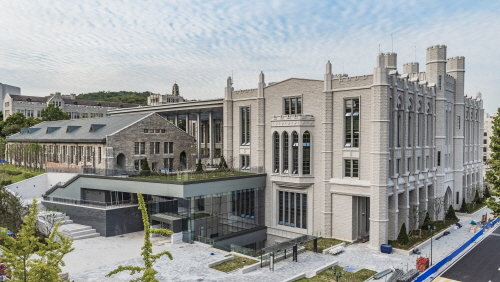
As part of its effort to spearhead the innovation of university education, Korea University, led by President Jin Taek Chung, introduces a future-oriented education building which befits the recent transition period in the history of civilization.
◆ Innovation of Education ◆
The recently completed SK Future Hall is expected to bring about the innovation of education. To be specific, the circumstances around the building, including its design and university classes scheduled to be provided in the building, are all expected to lead to the settlement of flipped-class and tutorial systems in the university. Those systems are known for encouraging students to listen to video lectures before coming to real-world seminar rooms. In the seminar rooms, students, grouped in small numbers, are expected to share their thoughts on what they have seen in the videos and discuss with others.
In addition to the seminar rooms, individual study rooms with carrel desks can be a place where students can take their study to the next level. Individual study rooms, approximately 3.3 square meters each, are perfectly shaped to boost the effect of self-directed learning. The SK Future Hall, consisting of 106 labs and group-study rooms, and individual study rooms with 113 carrel desks, is expected to suggest a new standard for a university building of the future through providing a place for self-learning and free discussion to students.
◆ Innovation of Space ◆
On Nov. 17, 2016, ground was broken for the SK Future Hall. After 3 years of construction, a completion ceremony for the building took place on Nov. 12, 2 p.m. The building, with 5 stories above ground and 2 underground levels, has a gross floor area of 27,370.61 square meters.
With the Main Hall, one of the symbolic buildings for Korea University, as the center, on the right side of the Central Plaza, the Centennial Memorial Samsung Hall / Museum stands. While the Samsung Hall / Museum, completed in 2005, commemorates the university’s centennial, the SK Future Hall on the left side of the plaza will be a monument for the millennium of the university.
The Hana Plaza, featured with its signature glass ceilings, connects the existing Auditorium with the SK Future Hall. With a capacity of approximately 700 persons, the Hana Plaza will work as a thoroughfare between the old and new buildings, integrating students from both places and boosting their communication. In addition to these conceptual benefits, the SK Future Hall is equipped with physical features derived from cutting-edge technologies. It has the ICT/IoT technology experience and exhibition spaces, and its own geothermal heating system. Most of the energy-related products used inside the building are energy efficiency grade 1 and/or environmentally friendly. In terms of the university’s master-plan, the building is monumental as it completes the master plan for the construction of a future-oriented campus.
Spaces and rooms inside the building are arranged in accordance with atypical and cyclic flows of human traffic, which removes any uniform iteration from space arrangement. Most of the rooms and spaces are different shapes and sizes. Every floor has its signature color; yellow for the basement floor, representing hope and newness; crimson for the 1st and 2nd floors, meaning openness and passion; green for the 3rd, symbolizing growth and harmony; blue for the 4th, seeking for concentration and intelligence; and purple for the top floor, symbolizing creativity and change.
If any graduates from Korea University are asked which place in the university has made the biggest impression on their memory, most of them would pick the Auditorium. The SK Future Hall is all the more meaningful as it is connected with the Auditorium via Hana Plaza. By restoring those good old days as much as possible, the university wants its SK Future Hall to become a space where the past, present, and future of the university co-exist.
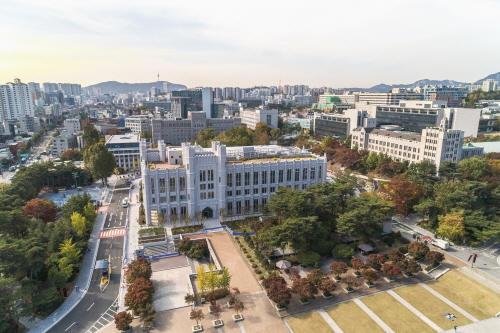
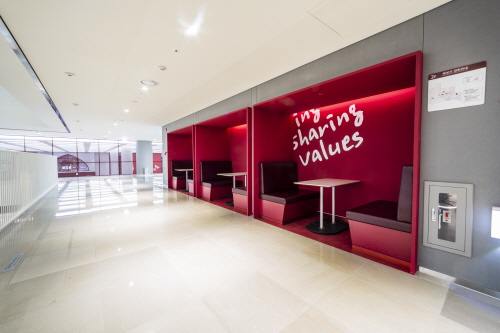





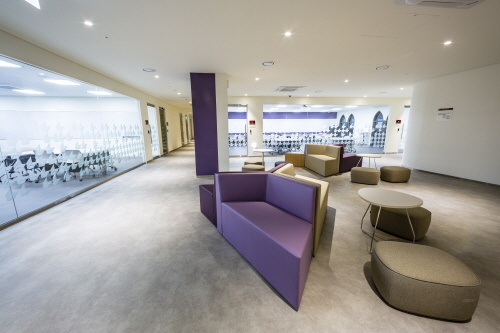
◆ Realization of Smart Campus based on ICT/IoT ◆
The SK Future Hall is regarded as the realization of so-called smart campus where its users and residents are encouraged to connect via their digital devices. Utilizing the Internet of Things, block chain technology, and artificial intelligence, the building has a system which allows its users to reserve rooms, control their entrance and residence record, and monitor sensors with their mobile devices. The building is a sort of large-scale test bed and experience center for the ICT/IoT-based smart campus.
For example, you can reserve a study room with your smart phone. As soon as you place your smart phone on the entrance control pad, your application for the study room is approved. This will make it easy for students to find spaces to study by themselves or discuss with others. The study room use record is controlled by block chain technology and linked to the accumulation of usage. Study room rental is also available for alumni members and locals in the neighborhood. Lecture rooms are equipped with sensors for temperature and humidity, even for high decibels (e.g. screaming), securing a comfortable as well as safe environment. SK Telecom has played a leading role in building the entire smart system for the building.
As part of the university’s effort to encourage participation from its faculty and students, one of the state-of-the-art technologies developed by Professor Lynn, Choi from the School of Electrical Engineering is harnessed: large-scale indoor positioning technology using a geomagnetic field with deep neural networks. The research team led by Professor Choi achieved the average localization accuracy of less than one meter with their model, which means that they succeeded in substantially improving the localization performance compared to the existing techniques. As their model does not require any equipment other than a smart phone, it will make the SK Future Hall a real-world testbed and be applied to the building for the first time in the world. Its application will include the indoor guide map, electronic roll books, etc.
To transform its campus to a smart one, Korea University founded the ICT/IoT Campus Committee. The committee is in charge of developing systems and technologies, establishing service policies, and drawing up a budget based on the results of surveys answered by faculty members and students.
According to the survey, the utilization of empty spaces received the most votes, which has made the university decide to start the study room rental service first. The smart campus will be run in a way that reflects the needs of students. Based on the test results from the SK Future Hall, Korea University has a plan to expand its smart campus system and apply it to the entire campus.
The university runs its smart campus with its data hub, where all the data in and outside the university are collected, as the center. Recently, the university opened its own data hub website (https://data.korea.ac.kr), built on an open-source system to which artificial intelligence can be applied. From the website, you can check the results of various analyses, including the analysis result of course registration and that of current status of interdisciplinary studies. Results of major data analysis are sent in a newsletter format by the university to its faculty and students on the 1st day of every month.
Integrating technologies to collect, transfer, and analyze data, and to formulate policies based on the analysis results as one system is the foundation for the ICT/IoT-based smart campus.
The smart campus is expected to be an example of the realization of a data-based, ever-evolving campus equipped with technology developed by its own faculty. The realization project will be carried out, taking account of various aspects such as data sharing and access, and streamlining paperwork.
Korea University has outlined a plan to connect its five campuses (Seoul / Sejong / Anam Hospital / Guro Hospital / Ansan Hospital) all together with the data and ICT/IoT infrastructure, which is expected to suggest a model for smart city construction projects, one of the technology-related issues in the limelight.
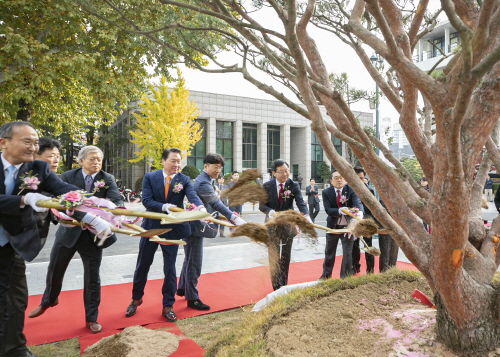
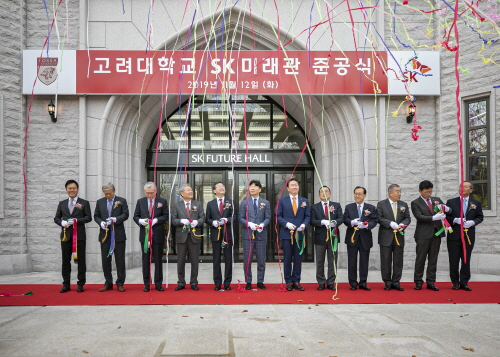
◆ Space Built with Donors’ Support ◆
When the announcement of the SK Future Hall construction project was made, faculty and alumni members of Korea University voluntarily reached out to the university. Over 1,200 alumni members made donations for the project. Group-study rooms and individual study rooms with carrel desks at the Hall will be named after the donors. Some of them will have their names engraved on the Wisdom Columns and Donors’ Wall.
The Auditorium will also have the names of some donors engraved inside the building. Over 600 donors have supported the Auditorium remodeling project. Their names are engraved on the backs of chairs at the building, waiting for students to sit on.
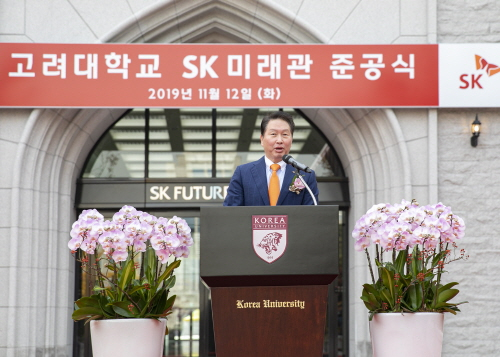

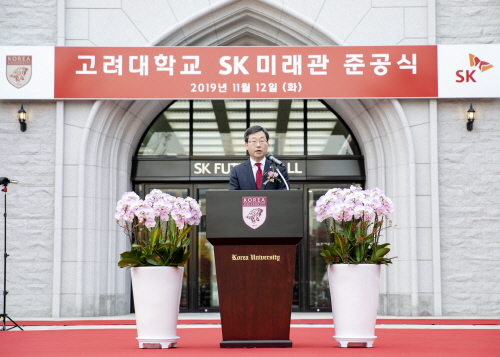
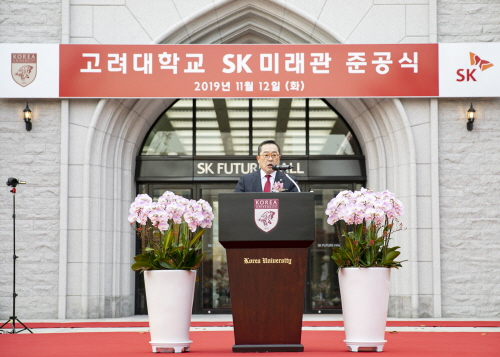
Chairman Tae-won Chey of SK Group addressed the completion ceremony. “It has been over 30 years since I graduated from the university. Just like the campus that time and that of the present are completely different, there have been significant changes in the role and social responsibilities that a university should take. The world changes faster and more intensely. Similar to the mobile technology which has brought about remarkable changes in the environment surrounding university students, the state-of-the-art technologies such as artificial intelligence will lead to more changes down the road,” said Choi. He continued, “The role of a university, so far, was to teach their students so that they can acquire knowledge. However, the ultimate goal of knowledge accumulation is closely linked to cultivating virtue and making the world a better place for everyone. I believe the SK Future Hall will be an outpost for Korea University to lead innovations in our society. I hope 10, 20, and even 30 years later, the SK Future Hall will be a space where anyone can dream of their bright future.”
Chairman Jae-ho Kim of the Korea University Foundation expressed his high expectations for the building. “Talented personnel with capabilities that differ from the past is what we need most for Korea to advance to the next stage. They should have professional expertise, think in a creative way, and know how to communicate effectively to find solutions. Beyond the conventional education system which only focuses on knowledge transfer, nurturing creative and talented personnel is the mission for universities of today.” He continued, “The SK Future Hall is composed with spaces of new concepts from which creative and talented personnel can grow. Here, students will find out how to come up with creative solutions and learn how to cooperate and communicate with others.”
President Jin Taek Chung of Korea University also delivered his congratulatory remarks at the ceremony. “The more uncertain our times are, the more necessity we feel to have talented personnel who challenge those uncertainties without fear. They are the ones who respect diversity, harmonize with others based on close communication, and are capable of achieving social innovations. To nurture such talented personnel, we should be prepared first to provide an environment where vocations and dignities of everyone are respected and where everyone can make the most out of their own capabilities.” He continued, “Having the SK Future Hall completed today, now we can say that we prepare a place where the KU faculty and students can create new values for our future. Here, they communicate, cooperate, and discuss with each other, transcending the invisible walls of different majors and study areas. Taking this building as a new starting point, all the KU faculty and students will voluntarily focus on what they have been trying to accomplish. Their achievements will have valuable meanings for our society and for the nation. This is exactly the way Korea University should take if it wants to develop as an educational institution having an emphasis on creating new values and leading innovation.”
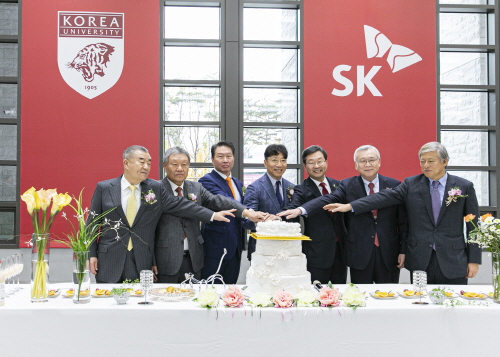
President Ja-Yeol Koo of the Korea University Alumni said at the ceremony, “Quite an extensive amount of effort has been poured into the SK Future Hall project, from design to construction, to make the building a place for encouraging creative thoughts and creating interdisciplinary knowledge. The building, optimized for nurturing future intellectuals who will be leading the Fourth Industrial Revolution Era, will be a new landmark for the university. Furthermore, it will last forever in the history of Korea University as a symbol of the future-oriented university.”



